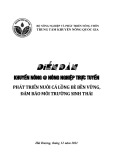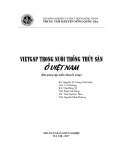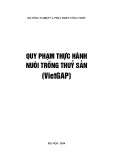
Int.J.Curr.Microbiol.App.Sci (2020) 9(11): 922-928
922
Original Research Article https://doi.org/10.20546/ijcmas.2020.911.110
Effect of Biodegradable Municipal Compost and Chemical Fertilizer
on Yield, Nutrient Content and Uptake of Kharif Rice in
New Alluvial Zone of West Bengal
Suman Samui*, Sukanta Pal and Biplab Show
Department of Agronomy, Bidhan Chandra Krishi Viswavidyalaya, Mohanpur,
Nadia, West Bengal, India
*Corresponding author
A B S T R A C T
Introduction
Rice (Oryza sativa L.) is one of the most
important cereal crops of India and is used as
a staple food for more than 60% of the total
population of the country (DAC, 2010). It
accounts for about 43% of total food grain
production and 55% of total cereal production
in India (Singh et al., 2012). About 56% of
West Bengal’s gross cropped area has been
occupied by rice and ranks first in terms of
cultivated area (Directorate of Agriculture,
Go W.B, 2018). The average yield of rice in
West Bengal (2.88 t ha-1) has augmented as a
result of several research activities, but it is
still much less than other leading rice growing
states in the country. In India, during the past
three decades intensive agriculture involving
high yielding varieties of rice has led to
heaving withdraw of nutrients from the soil.
Furthermore, imbalance use of only chemical
fertilizers by farmers has deteriorated soil
health and declines soil organic carbon
content, which is the threat to sustainability.
International Journal of Current Microbiology and Applied Sciences
ISSN: 2319-7706 Volume 9 Number 11 (2020)
Journal homepage: http://www.ijcmas.com
Effect of municipal biodegradable waste on rice was studied during kharif seasons of 2018
and 2019 at Regional-Research Sub-Station (RRSS) Chakdaha of BCKV under New
Alluvial Zone of West Bengal. The experiment was laid out in Randomized Complete
Block Design (RCBD) with seven treatments viz., T1: Absolute control (No inorganic &
No compost); T2: Recommended Dose of Fertilizer (RDF); T3: RDF + Krishi Rasayan
(KR) Compost (Commercial compost) @ 3.75 t ha-1; T4: RDF + Ecovio (E.V.) Compost
(source separated organic waste material) @ 3.75 t ha-1 ; T5: 50% RDF + KR Compost @
3.75 t ha-1 ; T6: RDF + Krishi Rasayan Compost @ 3.75 t ha-1 + Mulch (Decomposible
polythene Mulch); T7: RDF + Ecovio Compost @ 3.75 t ha-1 + Mulch (Decomposible
polythene Mulch) replicate thrice. Experimental results revealed that all the growth and
yield attributes were recorded maximum in the treatment receiving recommended doses of
fertilizer along with chemical fertilizer integration with Ecovio Compost @ 3.75 t ha-
1which ultimately reflect the maximum grain yield grain yield of 4.98t ha-1. Highest
nutrient content (NPK) and uptake of grain and straw were also noticed in same treatment.
K e y w o r d s
Municipal
biodegradable
waste, Commercial
compost, Chemical
fertilizer, Yield,
Nutrient content
and uptake, Rice
Accepted:
10 October 2020
Available Online:
10 November 2020
Article Info

Int.J.Curr.Microbiol.App.Sci (2020) 9(11): 922-928
923
Application of chemical fertilizer without
conservation of soil fertility not only results in
depletion of soil nutrient reserve but disrupts
the biological balance of soil-plant system
also. Therefore, it is time to look for measures
to stimulate sustainability in production of
rice on long term basis (Mandal and
Adhikary, 2005). On the other hand switching
on food production to organic would lower
crop yields, we can use all the organics that
are available but we are not going to feed six
billion people with organic fertilizer or
materials. Therefore, pure organic agriculture
will not be the substitute to combat against
the harmful effect of pure chemical
agriculture. At this juncture, it is essential for
us to evolve and adopt a strategy of integrated
nutrient supply by using a judicious
combination of chemical fertilizers, organic
manures and biofertilizers (Swaminathan,
1981).
Traditional composting of organic matter
wastes has been known for many years but
new methods of thermophilic composting
have become much more popular in organic
waste treatment recently since they eliminate
some of the detrimental effects of organic
wastes in the soil. Composting has been
recognized as a low cost and environmentally
sound process for treatment of many organic
wastes (Hoitink, 1993). Municipal waste
composting not only a viable option for
municipal solid waste management (MSWM)
but also desirable – socially, economically
and environmentally. Organic waste
composting techniques have been extensively
developed in recent decades in response to the
increasing concern regarding management of
waste. On an average, an individual produces
about 250-400g of wet wastes per day. In
Bangalore city alone, about 6000 tonnes of
garbage is being produced each day and the
solid waste is not utilized scientifically. The
wet waste contains enormous quantity of
major and micro nutrients that are useful in
agriculture as organic resources. Recycling of
waste is possible for better utilization in
agriculture, and if it is properly managed, it
could be a valuable and alternative resource
of plant nutrient for the imported and
expensive inorganic fertilizers. Composting
municipal solid waste is a method of diverting
organic waste materials from landfills while
creating a product, at relatively low-cost, that
is suitable for agricultural purposes. This
trend may be attributed to economic and
environmental factors, such as municipal
landfill capacity, costs associated with land
filling and transportation of materials,
decreasing the use of commercial fertilizers,
increasing the capacity for household waste
recycling and improved quality of compost
products. Keeping these in view, a field study
was carried out to find out the use of
municipal compost along with chemical
fertilizers as a source of nutrients for rice
crop.
Materials and Methods
Field trial was conducted in the sub Regional
Research Sub-Station (RRSS), Chakdaha,
Nadia under Bidhan Chandra Krishi
Viswavidyalaya, Mohanpur, West Bengal
(located at 2305.3ʹN latitude and 8305.3ʹE
longitude and at an elevation of 9.75 meters
above the mean sea level), during kharif season
of 2018 and 2019 on rice (cv. IET 4786).The
climate of the experimental site is humid
subtropical with mild short winter and hot
humid long summer. The experiment was
conducted under irrigated shallow low land
situation, having medium fertility status with
good drainage facility. The experimental soil
was sandy loam in texture (order Inceptisol),
neutral in reaction (pH 7.5) and medium in total
nitrogen (187.5 kg ha-1), available phosphorus
(16 kg ha-1) and available potassium (129 kg ha-
1). The experimental site has average rainfall of
1450 mm, 75% of which is received during
June to September.

Int.J.Curr.Microbiol.App.Sci (2020) 9(11): 922-928
924
Field trial was designed in a simple
randomized complete block design (RCBD)
with three (3) replications and seven
treatments [T1: Absolute control (No inorganic
& No compost); T2:Recommended Dose of
Fertilizer (RDF); T3: RDF + KrishiRasayan
(KR) Compost (Commercial compost) @ 3.75
t ha-1; T4: RDF + Ecovio (E.V.) Compost
(source separated organic waste material) @
3.75 t ha-1 ; T5: 50 % RDF + KR Compost @
3.75 t ha-1; T6: RDF + KrishiRasayan
Compost @ 3.75 t ha-1 + Mulch
(Decomposible polythene Mulch); T7: RDF +
Ecovio Compost @ 3.75 t ha-1 + Mulch
(Decomposible polythene Mulch)]. Nitrogen,
phosphorus and potassium at the rate of 60,
30 and 30 kgha-1 in the form of urea, SSP and
MOP across all treatment was considered
RDF. One-fourth (¼th) N along with full P2O5
and ¾th K2O of RDF were applied as basal
(during final land preparation). Remaining ½
N was top-dressed at tillering stage, while ¼th
each of N and K2O was given at panicle
initiation stage. Municipal composts were
applied to the individual plots one week
before transplanting. Well germinated seeds
of Satabdi (IET-4786) were sown on 26th June
and 28th June of 2018 and2019 respectively
25 days old seedlings were transplanted @ 3
seedlings per hill with a spacing of 20cm x
15cm in both the years. All the plots were
separated by about 20 cm ridges to stop
water/nutrients movement among the
treatments. Water to each treatment was
distinctly applied from irrigation channel. All
other agronomic practices were done
uniformly for all the trail units during rice
growing season. The individual plot size was
14m × 7m. The crop was harvested when the
plant become yellowish to brown and had
around 14% grain moisture during 3rd week of
October. Harvested crops were kept in the
field for 2-3 days for sun-drying and then
threshing was done. Grain and straw were
then properly sun-dried, weighed and finally
converted into t/ha. Plant samples from each
treatment were collected, oven-dried, and
ground for analyzing total recoveries of N, P
and K at harvesting following standard
procedures.
Data on all measured attributes of rice was
subjected to analysis of variance (ANOVA)
according to the techniques define for simple
randomized complete block design (RCBD)
as described by Gomez and Gomez (1984).
Means between treatments were compared via
CD (Critical difference) test (p≤0.05).
Pearson’s correlation co-efficient was
calculated to describe the degree and pattern
of associations between observed traits of
tested rice cultivar.
Results and Discussion
Yield and harvest index
Grain yield, straw yield and harvest index
were significantly varied among the different
combinations of nutrient management (Table
1). Grain yield ranges from 2.98 t ha-1 in
control treatment to 4.98 t ha-1 in plots treated
with chemical fertilizer integration with
Ecovio compost and biodegradable mulch
(T7). The percentage increase in the grain
yield of rice was the lowest (37.6%) in T5
(50% RDF + KrishiRashayan Compost) while
the highest percent increase in rice grain yield
(67.1%) was observed in T7 treatment. With
respect to the control plot, application of
biodegradable mulch in the plots receiving
integrated use of organic manures and
chemical fertilizers resulted in higher percent
of grain yield (64.93%) compared to the no
mulch treated plots (52.46%).All the
treatment combinations are statistically at par
with T7 except T1 and T5 treatments. Kavitha
et al., (2007) also found that the enriched
waste compost treatment in conjunction with
inorganic fertilizer has produced higher grain
yield than the application of inorganic
fertilizer alone.

Int.J.Curr.Microbiol.App.Sci (2020) 9(11): 922-928
925
Table.1 Effect of municipal compost and chemical fertilizer on yield and harvest index of kharif rice (mean data of 2 years)
Treatment
Grain Yield (t ha-1)
Straw Yield (t ha-1)
Harvest Index (%)
T1: Absolute control
2.98
4.78
38.40
T2: Recommended Dose of Fertilizer (RDF)
4.96
5.10
49.31
T3: RDF + KR Compost @ 3.75 t ha-1
4.73
4.80
47.36
T4: RDF + Ecovio Compost @ 3.75 t ha-1
4.80
5.15
48.70
T5: 50 % RDF + KR Compost @ 3.75 t ha-1
4.10
5.26
43.82
T6: RDF + KR Compost @ 3.75 t ha-1 + Mulch
4.85
5.30
47.76
T7: RDF + Ecovio Compost @ 3.75 t ha-1 + Mulch
4.98
5.16
49.11
S.Em(±)
0.16
0.07
0.85
CD (P=0.05)
0.493
0.216
2.619
Table.2 Effect of municipal compost and chemical fertilizer on nutrient content and uptake by straw (mean data of 2 years)
Treatment
N
P
K
Content
(%)
Uptake
(kg ha-1)
Content
(%)
Uptake
(kg ha-1)
Content
(%)
Uptake
(kg ha-1)
T1: Absolute control
0.896
42.83
0.370
17.69
2.225
106.36
T2: Recommended Dose of Fertilizer (RDF)
1.138
58.04
0.393
20.04
2.236
114.04
T3: RDF + KR Compost @ 3.75 t ha-1
1.192
57.22
0.405
19.44
2.238
107.42
T4: RDF + Ecovio Compost @ 3.75 t ha-1
1.246
64.17
0.405
20.86
2.241
115.41
T5: 50 % RDF + KR Compost @ 3.75 t ha-1
1.273
66.96
0.417
21.93
2.241
117.88
T6: RDF + KR Compost @ 3.75 t ha-1 + Mulch
1.354
71.76
0.463
24.54
2.267
120.05
T7: RDF + Ecovio Compost @ 3.75 t ha-1 + Mulch
1.408
72.65
0.417
21.52
2.333
120.38
S.Em(±)
0.00679
0.365
0.00114
0.076
0.002
0.196
CD (P=0.05)
0.02091
1.138
0.00353
0.238
0.007
0.612

Int.J.Curr.Microbiol.App.Sci (2020) 9(11): 922-928
926
Table.3 Effect of municipal compost and chemical fertilizer on nutrient content and uptake by grain (mean data of 2 years)
Treatment
N
P
K
Content
(%)
Uptake
(kg ha-1)
Content
(%)
Uptake
(kg ha-1)
Content
(%)
Uptake
(kg ha-1)
T1: Absolute control
2.140
63.78
1.3103
39.05
0.314
9.36
T2: Recommended Dose of Fertilizer (RDF)
2.225
110.36
1.3184
65.39
0.321
15.92
T3: RDF + KR Compost @ 3.75 t ha-1
2.395
113.28
1.3326
63.03
0.322
15.23
T4: RDF + Ecovio Compost @ 3.75 t ha-1
2.665
127.92
1.5434
74.08
0.324
15.55
T5: 50 % RDF + KR Compost @ 3.75 t ha-1
3.020
123.82
1.6873
69.18
0.326
13.37
T6: RDF + KR Compost @ 3.75 t ha-1 + Mulch
3.105
150.59
1.7258
83.70
0.327
15.86
T7: RDF + Ecovio Compost @ 3.75 t ha-1 + Mulch
3.147
156.72
2.2061
109.86
0.328
16.33
S.Em(±)
0.01725
0.640
0.01307
0.449
0.00019
0.052
CD (P=0.05)
0.05316
1.993
0.04029
1.399
0.00060
0.163














![Bài giảng Kinh tế thủy sản [mới nhất]](https://cdn.tailieu.vn/images/document/thumbnail/2025/20250808/kimphuong1001/135x160/91611754640469.jpg)

![Kỹ thuật nuôi thâm canh cá lóc trong ao đất: Tài liệu [chuẩn/mới nhất]](https://cdn.tailieu.vn/images/document/thumbnail/2025/20250724/kimphuong1001/135x160/3731753342195.jpg)




![Kỹ thuật nuôi cá nâu trong ao đất: Tài liệu [Mới nhất]](https://cdn.tailieu.vn/images/document/thumbnail/2025/20250723/vijiraiya/135x160/29781753257641.jpg)
![Kỹ thuật nuôi cá mú trong ao đất: Tài liệu [Mới nhất]](https://cdn.tailieu.vn/images/document/thumbnail/2025/20250723/vijiraiya/135x160/85681753257642.jpg)



